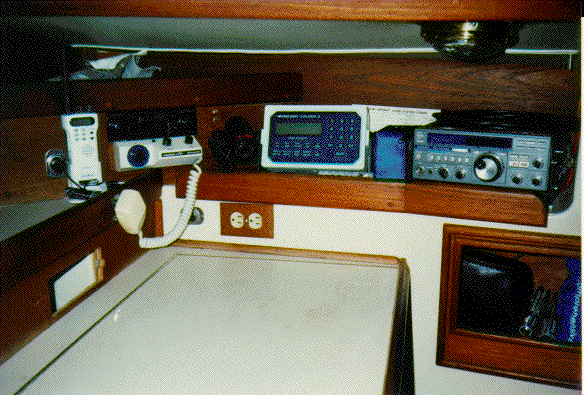
While underway, Tom was operating as XE2/KQ6NU on the HF amateur radio bands. Operation was primarily by single sideband (voice) with a few CW contacts thrown in.
The Latest Scoop
From Cabo south, we found conditions on 20M much better. Tom had a 59+ signal on 20M into San Diego, and the band is generally much quieter than 40M in the morning hours.
Our lifelines to the world back home were Tom's dad (also name Tom, W6SHY), and Denis, AA0YX in the same town and Tracy's parents. Another San Diego ham, Rod, W6MWB, completed the first phone patch to Tracy's parents early during Kaukoe's journey.
We were active on Marine VHF when in harbors bays and marinas and, as expected, everyone "connects" and passed information on to all (including the best restaurants and "watering" holes).
In the course of the trip, I managed to work all 50 states, and around 40 DXCC countries. Thanks for all the contacts! I am still trying to get caught up on QSL cards. If we talked during the trip, I'd love to have a card. There were hundreds of contacts on 8 bands (every HF band except 160m) and lots of good people to chat with.

The station on board is centered around a Yaesu FT-757GX transceiver. So far, our few contacts while underway have been made using Hustler center loaded verticals. Before the trip, when the rigging was replaced, we added two insulators to the backstay, so it can now be used as a random-wire antenna. The addition of an MFJ tuner completed the system.
The setup is as shown above, with the tuner matching the load seen by the transmitter, not actually tuning the antennna. This seems to be an acceptable compromise. The coax ends and the active part of the antenna starts at the stern rail, which is well grounded by copper strapping. This makes for about 40 feet of active radiator, with the upper end just a few feet from where the backstay attaches to the mast.

The picture of the chart table and nav station is already dated. Shown (from \ left) is the handheld marine VHF, AM/FM cassette, marine VHF below it, LORAN receiver, and Yaesu transceiver. The LORAN has been removed, and the tuner has been added in its place.
To learn more about amateur radio, visit the ARRL, or Tom's local club, PLARC.
Home ... Photo Gallery ... Route/Map ... Diary
This page created and maintained by
kaukoe@juno.com
Last changed on 23 July 98